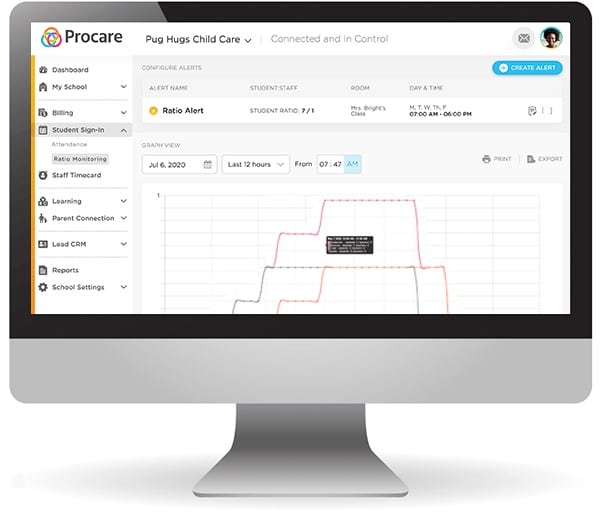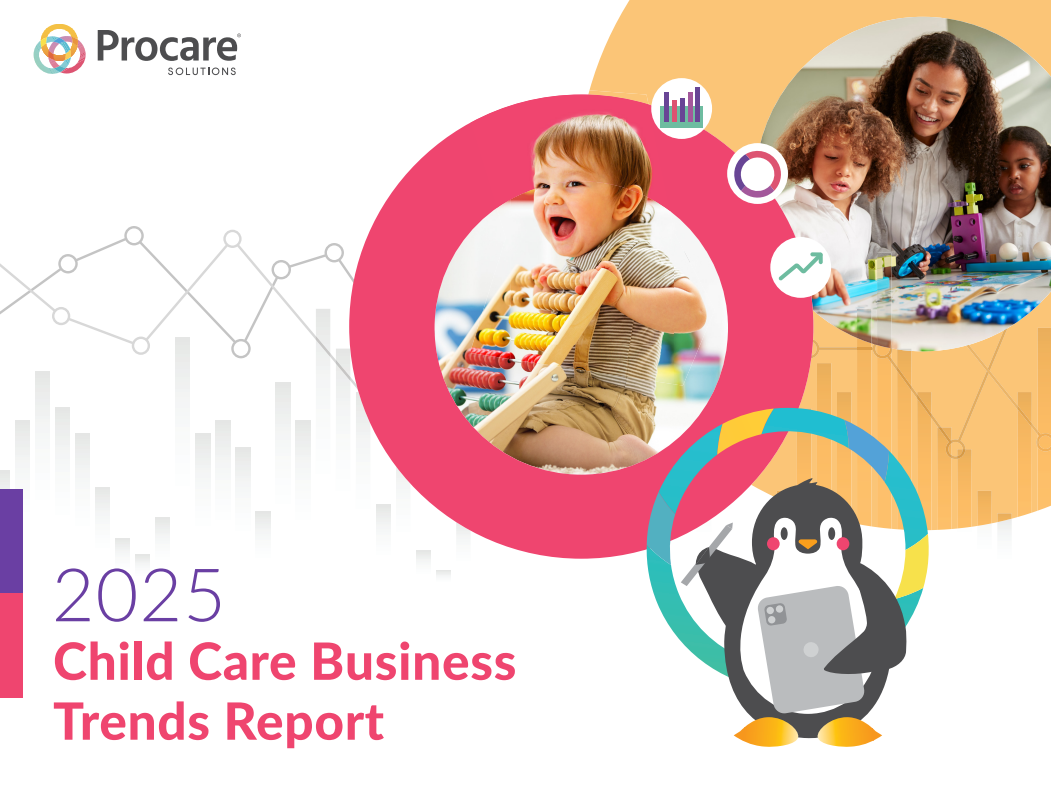
Education researchers have determined that staff-to-child ratios play an important role in supporting overall quality and education outcomes in child care facilities. As a result, and to help ensure child safety and wellbeing, staff-to-child ratios have been written into law in all 50 states.
In this blog post, we’ll take a closer look at staff-to-child ratios in child care, why they’re important, the most common staff-to-child ratios used for every age group, and the ideal staff-to-child ratio in child care.
What is Staff-to-Child Ratio in Child Care?
Staff-to-child ratio is a comparative measurement of the number of adult supervisors or child care providers versus the number of children in a child care group. A child care group with one child care provider for every five children would have a staff-to-child ratio of 1 to 5, or 1:5. A group with three supervisors and nine kids would have a ratio of 1 to 3, or 1:3.
Staff-to-child ratios are part of the legal requirements for child care centers in many places. In the United States, each state sets its own minimum standards for staff-to-child ratios in home- and center-based care facilities.
Minimum standards for staff-to-child ratios are designed to ensure child safety and allow for individualized learning and relationships between kids and child care providers. Staff-to-child ratios usually vary depending on the age(s) of the children, qualifications of the child care workers and the specific context of care.
What are the Most Common Staff-to-Child Ratios?
The National Association for the Education of Young Children (NAEYC) has published its own suggested best practices for minimum staff-to-child ratios and maximum class sizes for each age category:
| Age Group | Staff-to-Child Ratio | Maximum Group Size |
| Birth – 15 months (Infant) | 1:4 | 8 |
| 12 – 36 months (Toddler) | 1:6 | 12 |
| 30 months – 5 years (Preschool) | 1:10 | 20 |
| Kindergarten (Enrolled in public or private kindergarten) | 1:12 | 24 |
| Kindergarten – Third Grade (School Age) | 1:15 | 30 |
The United States Office of Personnel Management (OPM) also publishes a child care resources handbook with its own recommendations for staff-to-child ratios at child care centers within the appropriate group sizes:

These best practice recommendations were created to help parents identify high-quality child care providers, but they don’t necessarily reflect the staff-to-child ratio laws in every state. If you’re a child care provider or administrator, you’ll need to determine staff-to-child ratios in your area by reviewing the minimum standards for child care centers in your state.
You can start your search by visiting the National Database of Child Care Licensing Regulations. You’ll be able to choose your state and gain access to all relevant child care licensing regulations, including staff-to-child ratios and more.
Why are Staff-to-Child Ratios Important?

Ensuring Child Safety
Child safety is one of the primary concerns behind the creation of minimum standards for staff-to-child ratios in center-based care facilities. Maintaining adequate staffing in every child care group ensures that each child receives appropriate supervision and oversight of their immediate safety.
Staff-to-child ratios are highest for infants and toddlers, age groups that require virtually constant attention from adults to ensure their safety and meet their individual needs. As kids grow up, they become less reliant on adults to monitor their wellbeing, and lower staff-to-child ratios are permitted.
Providing Individualized Attention
Kids need individualized attention from their child care provider to support their development and overall wellness. Maintaining staff-to-child ratios ensures that child care providers can effectively supervise the entire group while engaging kids one-on-one as required to meet their needs.
For infants and toddlers, individualized attention frequently includes changing diapers, helping with meal times or comforting a crying child. As kids get older, individualized attention starts to include one-on-one lessons or activities that support educational, developmental and behavioral outcomes.
Relationships & Nurturance
Children do better when they have the opportunity to form relationships of trust and nurturance with their adult caregivers. Developing these relationships can be challenging when child care providers are responsible for too many children at once, so it’s important to maintain the appropriate staff-to-child ratio that allows each child to form a bond with their care provider.
Teaching & Learning
In education settings, most of us intuitively understand that larger class sizes can have a negative impact on learning outcomes. In larger classes, kids have less supervision and may be more likely to become disengaged and distract others. Larger classes also mean that teachers spend less time working with students on a one-to-one basis.
The same is true in child care settings, where minimum standards for child-to-staff ratios create guardrails so that each child receives sufficient attention from their caregivers as part of a high-quality early education.
Preventing Child Neglect
Maintaining appropriate staff-to-child ratios reduces the possibility for child neglect within a center. Neglect happens when child care providers fail to meet the basic needs of the children in their care, such as changing diapers, providing meals or helping with hygiene.
Child neglect doesn’t necessarily happen because care providers are mean-spirited – it can happen as a result of child care workers who are overwhelmed and distracted by having too many children to care for. Maintaining sufficient ratios allows the child care provider to have enough time to meet the basic needs of everyone they’re responsible for.
Quality of Care
The quality of care that each child receives depends on the quality and frequency of their interactions with child care providers. When each child care provider is responsible for a smaller group of kids, they can be more attentive and responsive to the needs of each child and provide more individualized attention and instruction. Researchers now agree that staff-to-child ratio is one of the key determinants of quality for early childhood education and care programs.
What is the Ideal Staff-to-Child Ratio in Child Care?

Smaller child care group sizes and staff-to-child ratios are considered to be strong predictors of positive interactions among child care providers and children, and the effective implementation of an age-appropriate curriculum. At the same time, smaller child care groups with more adult supervision result in higher labor costs for child care centers – costs that are ultimately passed on to parents.
Minimum staffing ratios must not only result in high-quality outcomes for kids, but also, they need to be economically viable for child care centers and the families who patronize them. In reality, a 1:1 staff-to-child ratio with unlimited group size may be the ideal ratio – but that doesn’t make it economically viable or realistic for families.
Families and child care centers should also be aware that while staff-to-child ratios are a predictor of child care quality, they aren’t the only predictor. Group sizes, compliance with guidelines for quality interactions, staff training and qualifications, the physical child care environment, and child care worker wages and working conditions have all been shown to predict the overall quality of care that kids receive.
Monitor Staff-to-Child Ratios at Your Child Care Center with Procare
For child care centers in the United States, maintaining staff-to-child ratios throughout the day is both a legal requirement and a necessity for ensuring quality child care.

Procare’s child care management app makes it easy for child care administrators to closely monitor staff-child ratios throughout the day. Administrators can leverage staff and student attendance data in real time to understand program occupancy and vacancies, assess staffing needs and inform business decision-making.
Ready to learn how Procare can help you meet compliance requirements associated with staff-to-child ratios. Talk to an Expert
Request a Demo
Request a demo and talk with one of our friendly Procare experts to get a tailored child care solution for the unique needs of your business.





